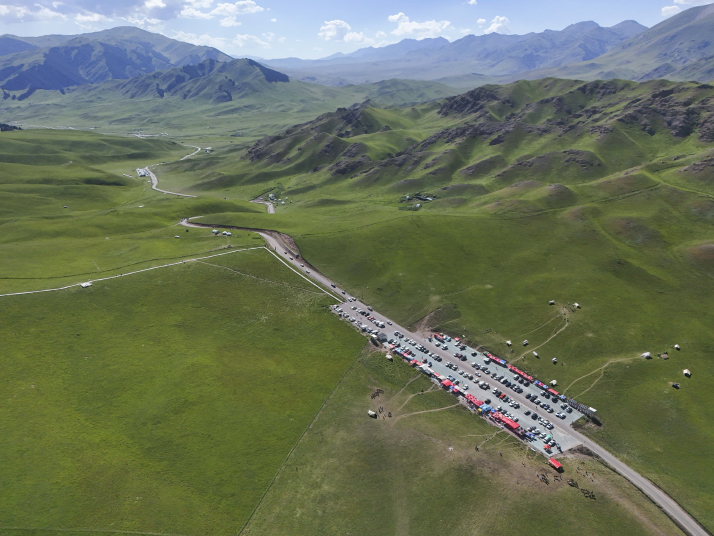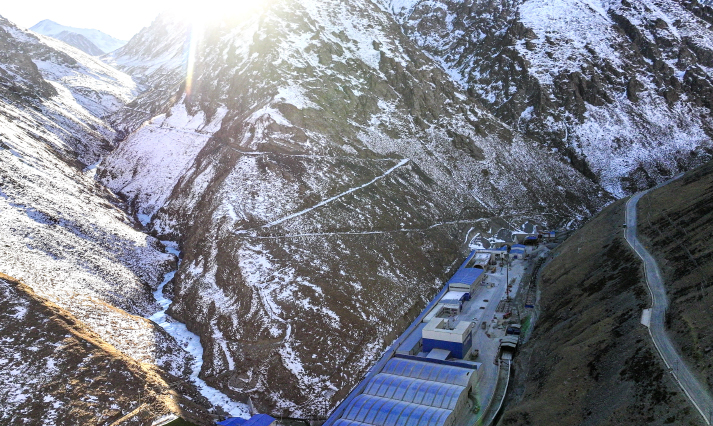| Xinjiang Today |
| Highway to prosperity | |
|
|
 People pose for a photo alongside the Altay-Hemu Highway in Xinjiang on June 30. The 209.45-km-long highway linking Altay City and Hemu Village officially opened that day (XINHUA)
In a refrigerated warehouse in the Jinghe International Rail-Road Intermodal Logistics Park in Bortala Mongolian Autonomous Prefecture in north Xinjiang, pallets of golden lemon are stacked high to the ceiling. Freshly arrived from Anyue, a county in the southwestern province of Sichuan renowned as China's "lemon capital," they are undergoing a final sorting before their journey to Almaty, Kazakhstan. What makes this shipment remarkable isn't just the produce but the speed: Within 24 hours of leaving this logistics hub, the lemons will reach the supermarkets of Central Asia.
"The secret lies in our seamless transfer system," Fang Wenbin, operations manager at Jinghe Xihai Public-Rail Logistics Operation Management Co. Ltd., told China Youth Daily while walking past workers loading crates onto waiting trucks. His pride is justified—the park's integrated rail-to-road cold chain has slashed typical transit times by nearly half. This has been made possible by Jinghe's location. The county is situated between two national-level ports, Alashankou (Alataw Pass) and Huoerguosi (Khorgas or Horgos), making it a key transportation hub. Here, important railways including the Lanzhou-Xinjiang, the Jinghe-Alashankou and the Jinghe-Yining-Huoerguosi railways converge, while the Lianyungang-Huoerguosi and the Jinghe-Alashankou expressways pass through it. This prime location has created a vital link between the domestic inland and markets in Central Asia and Europe. In addition, the facility boasts 18 temperature-controlled chambers where perishables can be preserved at precisely calibrated temperatures. Integrated smart monitoring technology provides 24/7 real-time tracking of environmental data, such as the temperature and humidity, with any anomaly triggering an instant alert. Zhao Qiang, deputy director of the logistics park, said thanks to the improved transportation network and storage technology, the park processed 496 million yuan ($68.3 million) worth of trade in the first quarter of 2025 alone, with agricultural exports growing 23 percent year on year. As China's largest provincial-level region, vast Xinjiang that is also the nation's northwestern frontier faces a challenging landscape of endless deserts and towering mountain ranges. Once this wilderness made transportation difficult, posing Xinjiang's greatest development obstacle. But through decades of construction, the region has built a comprehensive highway network across its vast territory and the expressways now serve as vital economic corridors that not only integrate north and south Xinjiang, but the entire region with the rest of the Eurasian continent and beyond.  A parking lot in a scenic area along the Yizhao Highway, a popular route for self-driving tours, on July 4 (XINHUA)
The evolution Xinjiang's highway development tells a story of extraordinary progress—from nonexistent infrastructure to primitive gravel roads, and then to the current sophisticated, multi-dimensional transportation network. The modern transformation of Xinjiang's transportation network began soon after the founding of the People's Republic of China in 1949, when the region took its first bold steps toward conquering its formidable geography. The year 1958 was pivotal, with the opening of the Urumqi-Kuerle (Korla) Highway—Xinjiang's first road to traverse the mighty Tianshan Mountains, connecting its south and north. A new era dawned in 1998 when the region's first highway, the Turpan-Urumqi-Dahuangshan Highway, opened. A new milestone was established last year, when the 22.13-km Tianshan Shengli Tunnel was completed, setting a world record for the longest highway tunnel. Once operational, this engineering marvel will reduce the time taken to drive across the middle section of the Tianshan Mountains from several hours to about 20 minutes. Data from the regional transportation department show that by the end of 2024, Xinjiang had 230,000 km of roads. All villages in the region now have access to paved roads and bus services. "A decade ago, the bumpy journey from Beijing to Urumqi took a full week. Now we can make it in just three days," veteran truck driver Zheng Yuewen, with over a decade of experience, said, reflecting on the transformation. "We drivers truly appreciate the benefits of better roads." Better transportation, greater trade When it's summer, it seems as if the ground in Turpan, famous for its lush vineyards producing seedless grapes, would ignite, due to the scorching heat. In Jiayi, a grape-growing village in Turpan, the vineyards are bursting with sweet seedless white grapes hanging like pearls from the vines. Not long ago, the rugged roads made transporting the grapes a challenge, resulting in considerable losses for farmers. Fortunately, with the recent upgrades to Xinjiang's highway network, smooth asphalt roads now connect directly to the highways. Newly built cold storage facilities ensure that the grapes can be transported under optimal conditions, reaching the market in prime condition. The transportation upgrades in Turpan are more than road improvements; they are part of a comprehensive transportation network that includes major highways like the Lianyungang-Huoerguosi Expressway and the Turpan-Hetian (Hotan) Expressway, as well as railways and air routes. This integrated system provides robust support for the local economy and the expansion of supply chains. According to Oubaidula Wumaier, general manager of Turpan Oubai E-commerce Co. Ltd., the company's annual sales of agricultural products are around 1,000 tons, due to the transportation and location advantages. During peak seasons, the business creates jobs for up to 500 people and has trained over 100 livestream hosts. This not only boosts the market competitiveness of local agricultural products but also provides employment opportunities for many young people in the area. In 2024, Turpan's GDP grew by 9.1 percent, with major increases in urban and rural residents' incomes. All of this can be attributed to the construction of the integrated transportation network, which is driving this ancient Silk Road hub toward a new era of prosperity.  A drone photo taken on December 30, 2024 shows the entrance of the Tianshan Shengli Tunnel in Urumqi (XINHUA)
Enhanced tourist experience The Yili River Valley lies at the heart of Xinjiang. On a blazing June day, as visitors arrived at the Kazanqi folk tourism area in Yining City, they were greeted by Kuerbanjiang Mamuti, a 69-year-old local who played the dutar, a traditional Uygur musical instrument. In his courtyard, where vines grew in profusion, a long table stood filled with seasonal fruits, naan bread and milk tea. The refreshments were meant for tourists coming from across the region. Cameras clicked and there was happy laughter at the feast. The scene used to be wildly different just a few years ago. The lane in front of Kuerbanjiang's home was a bumpy dirt path. "Back then, not only tourists but even locals rarely came this way," he told Xinhua News Agency. "Now things are different. The highway is open. During peak seasons, we welcome 500 to 600 visitors a day, earning nearly 20,000 yuan ($2,790) a month." The newly constructed Lianyungang-Huoerguosi Ex-pressway has made it easy for tourists to explore the stunning landscapes of north Xinjiang before arriving at this cultural gem. The Kazanqi folk tourism area has become a vibrant hub for experiencing the rich cultural diversity of the region. Visitors enjoy tea and snacks at Kuerbanjiang's home and are introduced to Xinjiang's folk customs. There are 88 such experiential places throughout Kazanqi, enhancing the visitor experience. The improved transportation has also spurred service upgrades in Kazanqi. Next to Kuerbanjiang's home, an old building that used to lie idle has been converted into a trendy B&B called the Blue Courtyard. Its owner Maiheliyamu Abulimiti said since the tourist route opened, it is fully booked during peak season. "A taxi from the airport to here takes just 20 minutes, and many visitors come back because of the easy access," she added. Local merchants also feel the positive impact. Yushanjiang Aishanjiang, who sells handmade ice cream, said previously, most customers were locals. "Now, with tour buses arriving, I can sell 300 to 400 servings a day." From a quiet old town to a bustling tourist destination, Kazanqi's remarkable transformation reflects the successful integration of transportation and tourism in Xinjiang. As Kuerbanjiang stated, "With roads unblocked, hope shines bright; golden days await ahead." Comments to luyan@cicgamericas.com |
|
||||||||||||||||||||||||||||
|